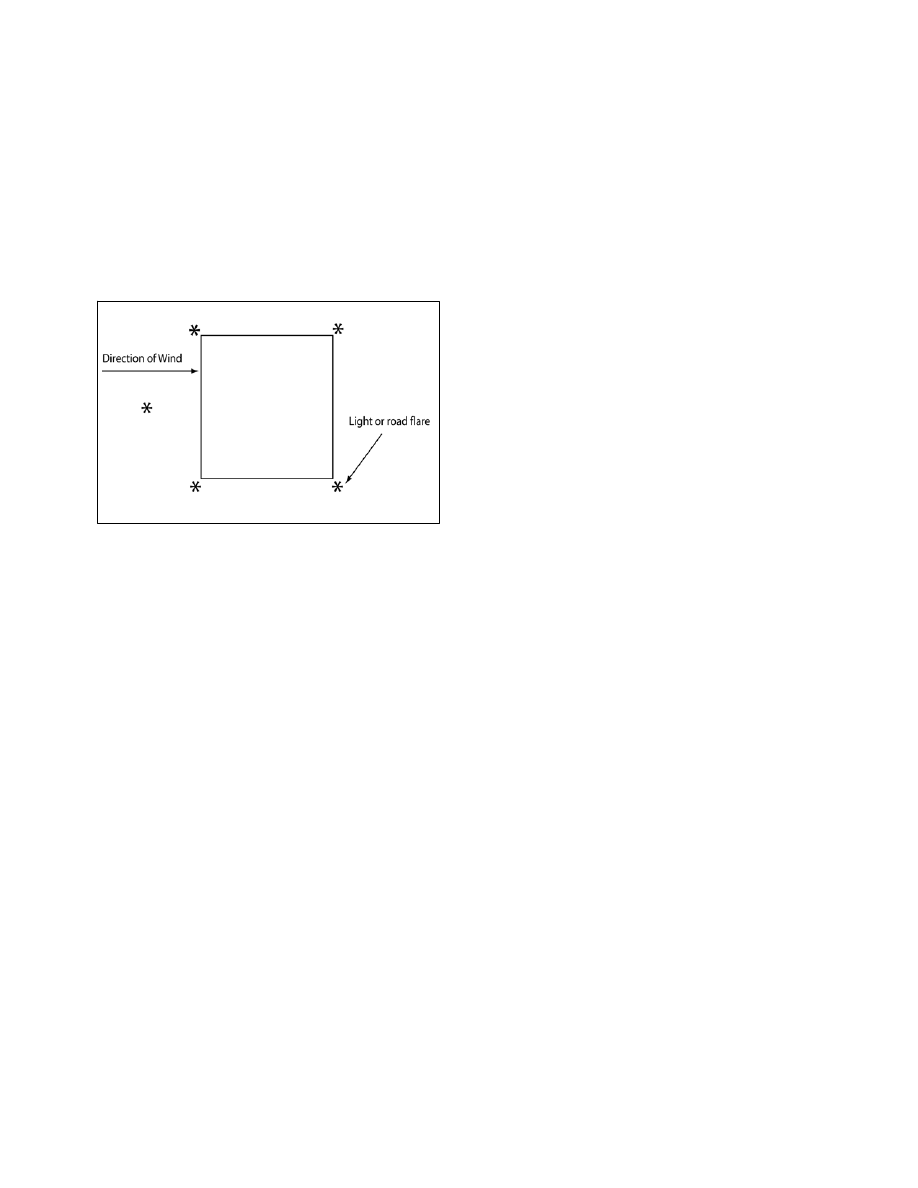
AIM
4/3/14
10−2−14
Special Operations
g. Night LZs
1.
There are several ways to light a night LZ:
(a)
Mark the touchdown area with five lights
or road flares, one in each corner and one indicating
the direction of the wind. See FIG 10−2−7.
FIG 10
−2−7
Recommended Lighting for
Landing Zone Operations at Night
NOTE
−
Road flares are an intense source of ignition and may be
unsuitable or dangerous in certain conditions. In any case,
they must be closely managed and firefighting equipment
should be present when used. Other light sources are
preferred, if available.
(b)
If chemical light sticks may be used, care
should be taken to assure they are adequately secured
against being dislodged by the helicopter’s rotor
wash.
(c)
Another method of marking a LZ uses four
emergency vehicles with their low beam headlights
aimed toward the intended landing area.
(d)
A third method for marking a LZ uses two
vehicles. Have the vehicles direct their headlight
beams into the wind, crossing at the center of the LZ.
(If fire/rescue personnel are available, the reflective
stripes on their bunker gear will assist the pilot
greatly.)
2.
At night, spotlights, flood lights and hand
lights used to define the LZ are not to be pointed at the
helicopter. However, they are helpful when pointed
toward utility poles, trees or other hazards to the
landing aircraft. White lights such as spotlights,
flashbulbs and hi−beam headlights ruin the pilot’s
night vision and temporarily blind him. Red lights,
however, are very helpful in finding accident
locations and do not affect the pilot’s night vision as
significantly.
3.
As in Day LZ operations, ensure radio contact
is accomplished between ground and air, if possible.
h. Ground Guide
1.
When the helicopter is in sight, one person
should assist the LZ Coordinator by guiding the
helicopter into a safe landing area. In selecting an LZ
Coordinator, recognize that medical personnel
usually are very busy with the patient at this time. It
is recommended that the LZ Coordinator be someone
other than a medical responder, if possible. Eye
protection should be worn. The ground guide should
stand with his/her back to the wind and his/her arms
raised over his/her head (flashlights in each hand for
night operations.)
2.
The pilot will confirm the LZ sighting by
radio. If possible, once the pilot has identified the LZ,
the ground guide should move out of the LZ.
3.
As the helicopter turns into the wind and
begins a descent, the LZ coordinator should provide
assistance by means of radio contact, or utilize the
“unsafe signal” to wave off the helicopter if the LZ is
not safe (see FIG 10−2−8). The LZ Coordinator
should be far enough from the touchdown area that
he/she can still maintain visual contact with the pilot.
i. Assisting the Crew
1.
After the helicopter has landed, do not
approach the helicopter. The crew will approach you.
2.
Be prepared to assist the crew by providing
security for the helicopter. If asked to provide
security, allow no one but the crew to approach the
aircraft.
3.
Once the patient is prepared and ready to load,
allow the crew to open the doors to the helicopter and
guide the loading of the patient.
4.
When approaching or departing the helicop-
ter, always be aware of the tail rotor and always
follow the directions of the crew. Working around a
running helicopter can be potentially dangerous. The
environment is very noisy and, with exhaust gases
and rotor wash, often windy. In scene operations, the
surface may be uneven, soft, or slippery which can
lead to tripping. Be very careful of your footing in this
environment.